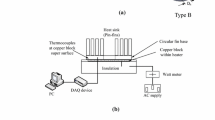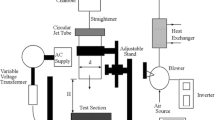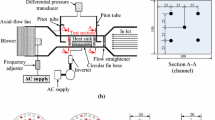Abstract
This study examines heat transfer performance under forced convection for two different types (Type A and Type B) of pin-fin heat sinks with and without a hollow in the heated base. The effects of the Reynolds number, heights of the fin and base plate, finning factor, heat sink porosity and perforated base plate on the heat-transfer coefficient, fin effectiveness and pressure drop were investigated and evaluated. The present study strongly suggests the use of a small hollow [(D h /D b ) < 0.15] constructed in the base plate of the pin-fin heat sink. In order to obtain insight into the fluid flow phenomena, flow visualization was also made to observe the detailed fluid flow characteristics of the present pin-fin heat sinks.









Similar content being viewed by others
Abbreviations
- a :
-
Channel cross sectional area (m2)
- A :
-
Surface area (m2)
- C p :
-
Specific heat of air
- d :
-
Hydraulic diameter of square (i.e. length of side) (m)
- D :
-
Diameter (m)
- h :
-
Average heat transfer coefficient (W/m2 °C)
- I :
-
Electric current (A)
- k :
-
Heat conductivity (W/m °C)
- L 1 :
-
Fin height (m)
- L 2 :
-
Base plate height (m)
- \(\dot{m}\) :
-
Mass flow rate of air (kg/s)
- N f :
-
Number of pin fins
- Q :
-
Heat transfer rate (W)
- Re :
-
Reynolds number
- T :
-
Temperature (°C)
- U :
-
Mean flow velocity in the channel (m/s)
- V :
-
Electric voltage (V)
- V a :
-
Air volume in heat sink (m3)
- V as :
-
Air volume plus heat sink volume in heat sink (m3)
- α :
-
Thermal diffusivity (m2/s)
- ϕ :
-
Heat sink porosity
- ɛ :
-
Fin effectiveness
- ν :
-
Kinematic viscosity (m2/s)
- ρ :
-
Density
- η :
-
Fin efficiency
- ψ :
-
Finning factor
- b:
-
Base plate
- c:
-
Convection
- cond:
-
Conduction
- f:
-
Fin
- film:
-
Film
- fm:
-
Mean fin
- fp:
-
Flat plate
- h:
-
Hollow
- hs:
-
Heat sink
- i:
-
Inlet
- in:
-
Input
- loss:
-
Loss
- m:
-
Mean
- net:
-
Net
- o:
-
Outlet or overall
- rad:
-
Radiation
- sm:
-
Mean surface
- t:
-
Total
References
Chang WR, Wang CC, Tsi WC, Shyu RJ (1985) Air-side performance of louver fin heat exchanger. In: The 4th ASME/JSME thermal engineering joint conference 4. pp 3467–3472
Li HY, Chao SM (2009) Measurement of performance of plate-fin heat sinks with cross flow cooling. Int J Heat Mass Transf 52:2949–2955
Dong J, Chen J, Chen Z, Zhou Y, Zhang W (2007) Heat transfer and pressure drop correlations for the wavy fin and flat tube heat exchangers. Appl Therm Eng 27:2066–2073
Wongwises S, Chokeman Y (2005) Effect of fin pitch and number of tube rows on the air side performance of herringbone wavy fin and tube heat exchangers. Energy Convers Manag 46:2216–2231
Kim TH, Kim DK, Do KH (2013) Correlation for the fin Nusselt number of natural convective heat sinks with vertically oriented plate-fins. Heat Mass Transf 49:413–425
Mesalhy OM, El-Sayed MM (2015) Thermal performance of plate fin heat sink cooled by air slot impinging jet with different cross-sectional area. Heat Mass Transf 51:889–899
Elsayed ML, Mesalhy O (2015) Studying the performance of solid/perforated pin-fin heat sinks using entropy generation minimization. Heat Mass Transf 51:691–702
El-Sayed SA, Mohamed SM, Abdel-latif AM, Abouda AE (2004) Experimental study of heat transfer and fluid flow in longitudinal rectangular-fin array located in different orientations in fluid flow. Exp Therm Fluid Sci 29:113–128
Li HY, Tsai GL, Chao SM, Yen YF (2012) Measurement of thermal and hydraulic performance of a plate-fin heat sink with a shield. Exp Therm Fluid Sci 42:71–78
Husain A, Kim SM, Kim KY (2013) Performance analysis and design optimization of micro-jet impingement heat sink. Heat Mass Transf 49:1613–1624
Kotcioglu I, Caliskan S, Baskaya S (2011) Experimental study on the heat transfer and pressure drop of a cross-flow heat exchanger with different pin-fin arrays. Heat Mass Transf 47:1133–1142
Li M, Li D, Xu S, Chen Y (2011) Experimentally study on liquid flow and heat transfer in micro square pin fin heat sink. Int J Heat Mass Transf 54:5602–5611
Sparrow EM, Ramsey JW, Altemani CAC (1980) Experiments on in-line pin fin arrays and performance comparisons with staggered arrays. ASME J Heat Transf 102:44–50
Al-Jamal K, Khashashneh H (1998) Experimental investigation in heat transfer of triangular and pin fin arrays. Heat Mass Transf 34:159–162
Deshmukh PA, Warkhedkar RM (2013) Thermal performance of elliptical pin fin heat sink under combined natural and forced convection. Exp Therm Fluid Sci 50:61–68
Kobus CJ, Oshio T (2005) Development of a theoretical model for predicting the thermal performance characteristics of a vertical pin-fin arrays heat sink under combined forced and natural convection With impinging flow. Int J Heat Mass Transf 48:1053–1063
Kobus CJ, Oshio T (2005) Predicting the thermal performance characteristics of staggered vertical pin fin array heat sinks under combined mode radiation and mixed convection with impinging flow. Int J Heat Mass Transf 48:2684–2696
Ashjaee M, Goharkhah M, Khadem LA, Ahmadi R (2015) Effect of magnetic field on the forced convection heat transfer and pressure drop of a magnetic nanofluid in a miniature heat sink. Heat Mass Transf 51:953–964
Ismail MF, Hasan MN, Ali M (2014) Numerical simulation of turbulent heat transfer from perforated plate-fin heat sinks. Heat Mass Transf 50:509–519
Adham M, Mohd-Ghazali N, Ahmad R (2012) Optimization of an ammonia-cooled rectangular microchannel heat sink using multi-objective non-dominated sorting genetic algorithm (NSGA2). Heat Mass Transf 48:1723–1733
Deshmukh PA, Warkhedkar RM (2011) Thermal performance of pin din heat sinks-a review of literature. Int Rev Mech Eng 5:726–732
Sahin B, Ward-Smith AJ (1987) The use of perforated plates to control the flow emerging from a wide-angle diffuser with application to electrostatic precipitator design. Int J Heat Fluid Flow 8:124–131
Spearman EP, Sattary JA, Reader-Harris J (1991) A study of flow through a perforated-plate/orifice-meter package in two different pipe configurations using laser Doppler velocimetry. Flow Meas Instrum 2:83–88
Patil SKR, Terry NT (2010) Control of separation using spanwise periodic porosity. AIAA J 48:174–187
Bae Y, Jeong YE, Moon YJ (2012) Computation of flow pasta flat plate with porous trailing edge using a penalization method. Comput Fluids 66:39–51
Tao J, Sun G (2015) A novel optimization method for maintaining aerodynamic performances in noise reduction design. Aerosp Sci Tech 43:415–422
Yahathugoda I, Akishita S (2005) Experimental investigation on surface impedance effect of sound radiation from low Machnumber flow around a circular cylinder. JSME Int J Ser B Fluid Therm Eng 48:342–349
Wen MY, Yeh CH (2015) Natural convective performance of perforated heat sinks with circular pin fins. Heat Mass Transf 51:49–58
Brigham BA, Vanfossen GJ (1984) Length to diameter ratio and row number effects in short pin fin heat transfer. J Eng Gas Turbine Power 106:241–245
Peng Y (1984) Heat transfer and friction loss characteristics of pin fin cooling configurations. J Eng Gas Turbine Power 106:246–251
Wen MY, Jang KJ (2003) An impingement cooling on a flat surface by using circular jet with longitudinal swirling strips. Int J Heat Mass Transf 46:4657–4667
Kline SJ, McClintock FA (1953) Describing uncertainties in single sample experiments. Mech Eng 75:3–8
Acknowledgments
The study was supported by the National Science Council of the Republic of China and the BROADLAKE CO., LTD (R.O.C.) through Grant No. NSC 101-2622-E-230-003-CC3.
Author information
Authors and Affiliations
Corresponding author
Rights and permissions
About this article
Cite this article
Wen, MY., Yeh, CH. Forced convective performance of perforated circular pin-fin heat sinks. Heat Mass Transfer 53, 1713–1723 (2017). https://doi.org/10.1007/s00231-016-1933-z
Received:
Accepted:
Published:
Issue Date:
DOI: https://doi.org/10.1007/s00231-016-1933-z




